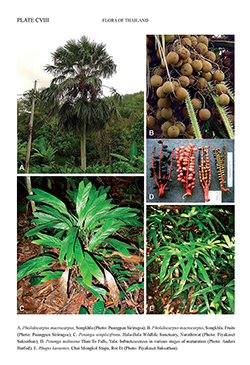e-Flora of Thailand
Volume 11 > Part 3 > Year 2013 > Page 483 > Arecaceae > Rhapis
1. Rhapis laosensis Becc.wfo-0000296176
Webbia 3: 225. 1910. Plate CVIII: E.
Accepted Name : This is currently accepted.
Description : Loosely clustered, shrubby to moderate-sized palm. Individual stems 1–2(–3) m, 0.8–1.5 cm diam. (without leaf sheath remnants), often rhizomatous basally. Leaves 8–20 in crown; leaf sheath 5–12 cm long; petiole 15–30 cm long, 0.3–0.5 cm across; blade ½–4/5-circular in outline, flattened to open funnel-shaped, darker and more glossy green above, up to 50 cm diam., evenly split to 1–9 cm from hastula, in 5–12, 15–27-folded segments. Male and female inflorescences similar, branched to 2 orders, to 25–35 cm long, basalmost rachis bract conspicuously inflated, rachis 5–10(–15) cm long with two first order branches, rachillae 5–15, 1.5–6(–10) cm long. Flowers 0.3–0.4 cm long, different sexual types of flowers similar, calyx regularly lobed, often with striate pigmentation, male and hermaphrodite flowers clearly longer than the female ones. Fruit ellipsoid to ovoid, 0.8–1.2 cm diam., borne on an ca 0.5 mm long receptacular stalk.
Thailand : EASTERN: Roi Et; NORTH-EASTERN: Mukdahan.
Distribution : Laos (type), Vietnam.
Ecology : Evergreen forests.
Vernacular : Chang (จั๋ง), sang (สัง)(Northeastern).
Uses: Ornamental.
Conservation Status: Although extremely common locally this species is vulnerable to unsustainable land development.
Notes: Restricted distribution in E and NE Thailand. Very common in Nong Phok district (Roi Et province) in the forest surrounding the Phra Maha Chedi Chai Mongkol temple. Distinguished by the leaves split to about halfway, the somewhat hooded segments and the inflated inflorescence bracts.

